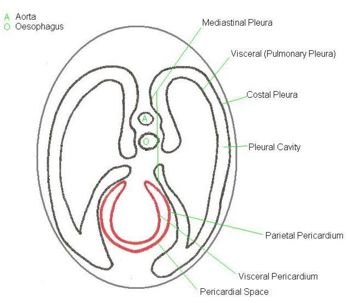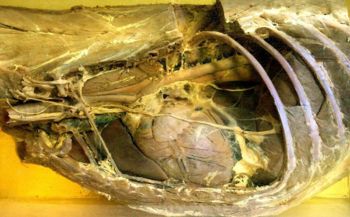Difference between revisions of "Pleural Cavity and Membranes - Anatomy & Physiology"
Fiorecastro (talk | contribs) |
Fiorecastro (talk | contribs) |
(No difference)
| |
Latest revision as of 14:44, 9 January 2023
Introduction
The surface of the inner wall of all of the body cavities is lined by a serous membrane which consists of a single layer of flat epithelium with a thin underlying propria (connective tissue). Within the thoracic cavity, this is known as the pleura. The visceral pleura which coats the outer surface of the lung is derived from the splanchnic mesoderm. The parietal pleura lining the thoracic cavity is derived from somatic mesoderm. The pleural cavity is a potential space between the two areas of pleural membrane, which normally are adhesed to each other.
Pleural Membranes
Structure of the Pleural Membranes
Each lung is placed within a separate layer of membrane, thus there are two pleural sacs. The space between the two sacs is known as the mediastinum, and is almost in the midline of the thorax. The pleura covering the surface of the lung is known as pulmonary pleura or visceral pleura. This becomes continuous with the mediastinal pleura, as it wraps around the lung. The diaphragmatic and costal pleura are continuous with the mediastinal pleura. Together, these three membranes are the parietal pleura.
Between the parietal and visceral pleura is the intrapleural space, or pleural cavity. This contains a small amount of serous fluid which establishes adhesion between the layers and allows smooth movement between the lung and chest wall, and between individual lobes of the lungs. The heart is invested in a parietal and visceral layer of pericardium with the pericardial space separating the two membranes. Cranially, the costal and mediastinal pleura adjoin to form a 'dome' of pleura which extends to the thoracic inlet. This is known as the cupulae pleurae. This region is only protected by soft tissue, and thus is vulnerable to injury.
Within the pleural sac encasing the right lung, there is a fold which encases the vena cava. It is known as the Plica Venae Cavae. The pleural membranes are larger than the lungs which they encase, thus there are areas where the facing surfaces of parietal pleura touch each other. These are known as pleural recesses. One example is the costodiaphragmatic recess, the space between the costal and diaphragmatic pleura. The volume of the recess varies to a point due to the phase of inspiration/expiration.
Pleural Membrane Function
The Pleural Cavity is filled with a small amount of serous fluid which forms a thin film of liquid between the pleural layers. This is vital in that it prevents separation of the two pleural layers and lubricates the surface, so the lungs can move easily within the thoracic cavity. The pleural fluid also provides surface tension, keeping the lung suitably close to the wall of the thorax, despite the lungs not being directly fixed to it. The pleurae thus allow the volume of the lungs to change with the volume of the thoracic cavity, enabling ventilation. The left and right pleural sacs are separate so that in the event of one being punctured, the other lung can continue to function effectively.
Vasculature
The pleural membranes are supplied by the bronchial and pulmonary arteries.
Innervation
Parietal Pleura is innervated by the intercostal nerves, with the mediastinal and diaphragmatic pleura also innervated by the phrenic nerve. Visceral pleura is innervated by the vagus nerve and sympathetic fibres. It is insensitive to pain stimuli.
Species Differences
In cattle, the mediastinum is a tough membrane, in contrast to horses, dogs and cats where it is rather thin and more delicate.
Birds do not have a pleural cavity as avian lungs do not have the capacity to inflate. The respiratory systems of non-homeotherms are also very different to that of mammals.
Links
Click here for information on pathology of pleural cavity membranes.
| Pleural Cavity and Membranes - Anatomy & Physiology Learning Resources | |
|---|---|
 Selection of relevant PowerPoint tutorials |
Histology of the respiratory system, including the pleural membranes |
References
Dyce, K.M., Sack, W.O. and Wensing, C.J.G. (2002) Textbook of Veterinary Anatomy. 3rd ed. Philadelphia: Saunders.
Budras, K.D., McCarthy, P.H., Fricke, W. and Richter, R. (2002) Anatomy of the Dog. 4th ed. Hannover: Schlutersche GmbH & Co. KG, Verlag und Druckerei.
| This article has been peer reviewed but is awaiting expert review. If you would like to help with this, please see more information about expert reviewing. |
Webinars
Failed to load RSS feed from https://www.thewebinarvet.com/respiratory/webinars/feed: Error parsing XML for RSS

